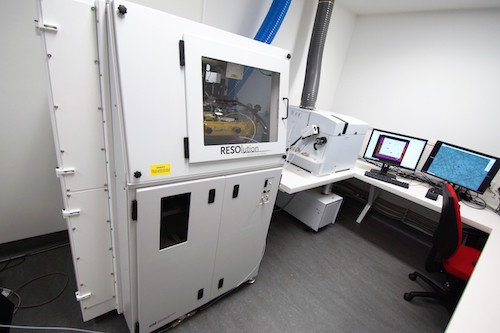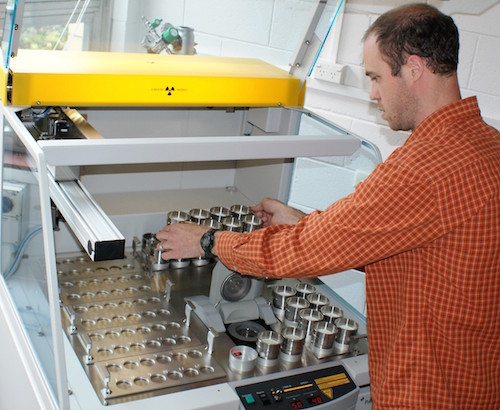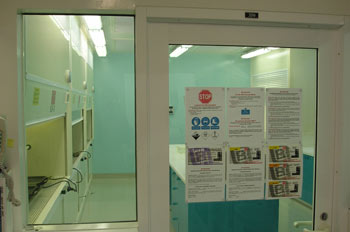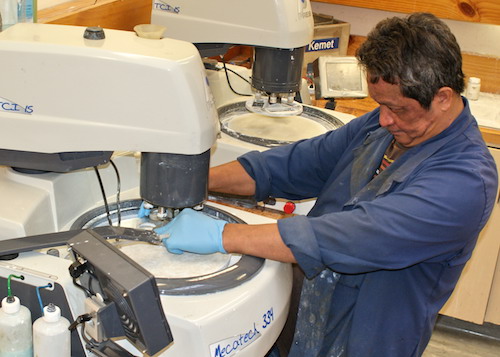CODES – Centre for Ore Deposit and Earth Sciences
CODES Analytical Laboratories (CAL)
CODES Analytical Laboratories (CAL) were established within the ARC Centre of Excellence in Ore Deposits, which operated at the University between 2005 and 2013, and have continued to operate and expand since then. Our vision is:
- To be at the forefront of analytical developments in the field of in-situ micro-analysis and bulk sample analysis of geological and other relevant materials.
- To ensure that research programs within CODES are underpinned by state-pf-the-art analytical capabilities thus enabling CODES to remain a research provider of choice for the minerals industry.
LA-ICP-MS Laboratory
 The laser ablation ICP-MS lab at CODES / Earth Sciences was established in 1998. It specialises in in-situ analyses of minerals, glasses and fluid inclusions. The lab houses 3 different laser types (213 nm and 193 nm solid state lasers and 193 nm Excimer lasers) and three different quadrupole mass spectrometer models. Laser microprobes are equipped with specialized laser cells allowing for fine-scale imaging of trace element distribution within mineral grains. The lab undertakes research into the laser ablation process and development of new applications. The laboratory welcomes external users, please contact CODES Analytical Laboratories.
The laser ablation ICP-MS lab at CODES / Earth Sciences was established in 1998. It specialises in in-situ analyses of minerals, glasses and fluid inclusions. The lab houses 3 different laser types (213 nm and 193 nm solid state lasers and 193 nm Excimer lasers) and three different quadrupole mass spectrometer models. Laser microprobes are equipped with specialized laser cells allowing for fine-scale imaging of trace element distribution within mineral grains. The lab undertakes research into the laser ablation process and development of new applications. The laboratory welcomes external users, please contact CODES Analytical Laboratories.
More information about the laboratory
XRF Laboratory
 CODES / Discipline of Earth Sciences XRF lab houses an Axios Advanced 4.0kW X-ray fluorescence spectrometer by Panalytical. The instrument is capable of fast throughput of samples for major and trace element analysis with its automated sampling system. The lab has all of the sample preparation facilities for making lithium borate disks for major element analysis and pressed powder pellets for trace element analysis. The laboratory welcomes external users.
CODES / Discipline of Earth Sciences XRF lab houses an Axios Advanced 4.0kW X-ray fluorescence spectrometer by Panalytical. The instrument is capable of fast throughput of samples for major and trace element analysis with its automated sampling system. The lab has all of the sample preparation facilities for making lithium borate disks for major element analysis and pressed powder pellets for trace element analysis. The laboratory welcomes external users.
More information about the laboratory
Solution ICP-MS and Clean Room
 The facility at CODES houses a class 100 clean room for processing samples in an ultra pure environment. The lab is equipped with a PicoTrace high pressure digestion system allowing for full dissolution of rock samples with resistant phases. Ultrapure Seastar grade reagents are used to ensure low blank levels and high data quality. Samples are analysed on an Agilent 7700 ICP-MS with a 3rd Generation Octopole Reaction System. . The laboratory welcomes external users.
The facility at CODES houses a class 100 clean room for processing samples in an ultra pure environment. The lab is equipped with a PicoTrace high pressure digestion system allowing for full dissolution of rock samples with resistant phases. Ultrapure Seastar grade reagents are used to ensure low blank levels and high data quality. Samples are analysed on an Agilent 7700 ICP-MS with a 3rd Generation Octopole Reaction System. . The laboratory welcomes external users.
Lapidary
 The facility is equipped with state of the art polishing and thin-section making equipment. There are numerous saws for cutting core, thin-sections, laser mounts, and polished sections, allowing for rapid turnaround time for sample submissions. Lapidary welcomes external users. For enquiries please contact CODES Analytical Laboratories.
The facility is equipped with state of the art polishing and thin-section making equipment. There are numerous saws for cutting core, thin-sections, laser mounts, and polished sections, allowing for rapid turnaround time for sample submissions. Lapidary welcomes external users. For enquiries please contact CODES Analytical Laboratories.
Other UTAS Analytical Facilities: CSL
A wide range of analytical facilities such as electron microscopy, stable isotope ratio analysis, vibrational spectroscopy and elemental analysis are located within University's Central Science Laboratory
Visit the CSL site
